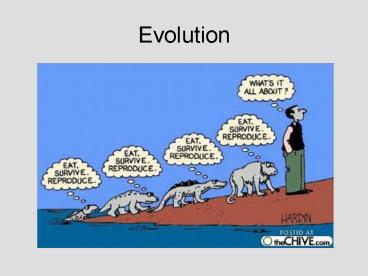Evolution - PowerPoint PPT Presentation
1 / 34
Title:
Evolution
Description:
Theories of Evolution ... Evolution – PowerPoint PPT presentation
Number of Views:159
Avg rating:3.0/5.0
Title: Evolution
1
Evolution
2
Evolution
Modern Humans
- Definition Change in a population of organisms
over time.
- Human evolution illustrated on a cladogram
3
Theories of Evolution
- Jean-Baptiste Lamarck 1809 published his theory
of evolution - Mechanism of Evolution Inheritance of Acquired
Characteristics
4
Theories of Evolution
- Charles Darwin 1859 published his theory of
evolution in the major work, On the Origin of
Species - Mechanism of Evolution Natural Selection
5
The Original Manuscript
- Most important book on biology ever published!
6
Lamarcks Ideas
- Organisms change over time
- Organisms are adapted to their environment
- They are continually changing and acquiring
features more suitable for their environment. - Continued ?
7
Larmarcks Ideas
- During an organism's lifetime, there is selective
use or disuse of its organs and traits. If a
trait isnt used?its lost.
8
Larmarcks Ideas
- Traits that are used are passed on to their
offspring. Over time, this process leads to the
change in a species. (hence the term
inheritance of acquired characteristics)
9
(No Transcript)
10
Darwins Ideas on Evolution
- Variation organisms show variation in each of
their traits height, colors of eyes/hair/skin,
resistance to disease, etc. - Natural selection Organisms better suited to
their environment survive and reproduce (also
known as survival of the fittest). - Fitness ability to survive and leave offspring.
No offspring No fitness.
11
Worksheets
- Natural Selection and fur color
- Evolution comparison of Lamarck (acquired
characteristics) and Darwins (natural selection)
ideas on evolution.
12
Darwins ideas on Evolution
- In the early 1800s, when Darwin was born, people
thought the Earth was a few thousand years old. - But by the 1820s, scientists hypothesized the
Earth was millions of years old. - 5000 years
- 5,000,000 years
13
Darwins ideas on Evolution
17-11 MYA
5 MYA-present
- An ancient Earth was necessary to support
Darwins ideas on evolutionpopulations change
over (long, long periods of) time.
35,000,000YA
12-6 MYA
55,000,000YA
14
Microevolution according to Darwins Ideas on
Natural Selection
Natural Variation in population of bacteria
15
Macroevolution according to Darwins Ideas on
Natural SelectionSpeciation formation of new
species
16
Genes and Variation
- Most phenotypes (traits) are polygenic.
- A graph of these traits often shows a bell curve.
17
Stabilizing Selection
- If individuals near the center of the bell curve
have higher fitness ( leave a greater amount of
fertile offspring) then stabilizing selection
occurs.
18
Directional Selection
- If individuals at one end of the bell curve have
higher fitness then directional selection occurs.
19
Disruptive Selection
- If individuals at both ends of the curve have
higher fitness than those in the middle then
disruptive selection occurs.
20
Genetic Drift
- If a small population is isolated from others of
the same species, it is possible that just be
chance one allele may become more common in a
population.
21
Genetic Drift
- For example The Bronx, NY, becomes built up and
trees are cut down. Few squirrels are able to
survive. However, one section of the Bronx is
set aside for the development of the Bronx Zoo.
Trees are NOT cut down in this area. By chance,
several of the gray squirrels in the area of the
zoo have black fur (a variation in fur color).
Over time, the allele for black fur becomes
common in this population.
22
How do new species form?Example Galapagos
Finches
- A small group of a species of finch arrives on
one of the Galapagos Islands - These finches do not usually fly across open
waterthey may have gotten lost or were blown
there by the wind.
23
Speciation continued!
- Over time these original finches may have ended
up on other of the Galapagos Islands through some
chance occurrence. - USUALLY the finches do NOT fly from one island to
another.
24
Speciation continued!
- The Galapagos Islands had different environments.
- Some had a low elevation and were dry with little
plant material.
25
Speciation continued!
- Others had a higher elevation with greater
rainfall and many plants.
26
Speciation continued!
- Directional selection occurs
- One island may have seeds that are large and
difficult to open. - Birds with a larger, thicker beak will have the
highest survival rate on this island
27
Speciation continued!
- Directional selection occurs
- Another island may have seeds that are small and
easy to open - Birds with a small, thinner beak will have the
highest survival rate on this island
28
Speciation continued!
- Reproductive Isolation if the populations
remain separate, and their gene pools continue to
change, eventually they can no longer mate with
each otherthey are then TWO NEW SPECIES!!! - On the Galapagos Islands this processes resulted
in the evolution of 13 different finch species.
29
- Darwins Finches
30
Evidence of Evolution
- Fossil Record
31
Evidence of Evolution
- Comparative Anatomy
- Homologous structures structures that have
different mature forms but develop from the same
embryonic tissue
32
Evidence of Evolution
- Vestigial organ organ that serves NO useful
function in an organism. - Wisdom teeth
- Appendix
HUMANS
Fingernails on Seals Fin
33
Embryology
NOTE Similarity of embryos of all of these
animals
34
Evidence of Evolution
- Similarities and dissimilarities in DNA code.
- Complete worksheet bar graph.































